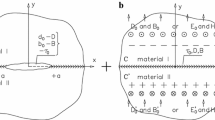Abstract
The singular characteristics of stress, electric displacement and magnetic induction fields near the tip of impermeable interfacial cracks in two-dimensional magnetoelectroelastic bimaterials are studied using the generalized Stroh formalism. Two types of singularities are obtained: one is the oscillating singularity 1/2±iε, the other is the non-oscillating singularity 1/2±κ. It is found that the non-zero parameters ε and κ cannot coexist for one transversely isotropic MEE bimaterial, a similar result is obtained for transversely isotropic piezoelectric bimaterials.
Similar content being viewed by others
References
Bracke, L.P.M. and Van Vliet, R.G., A broadband magneto-electric transducer using a composite material. International Journal of Electronics, 1981, 51: 255–262.
Feng, W.J, Nie, H. and Han, X., A penny-shaped crack in a magnetoelectroelastic layer under radial shear impact loading. Acta Mechanica Solida Sinica, 2007, 20: 275–282.
Li, G., Wang, B.L, Han, J.C. and Du, S.Y., Anti-plane analysis for elliptical inclusion in magnetoelectroelastic materials. Acta Mechanica Solida Sinica, 2009, 22: 137–142.
Feng, W.J., Pan, E. and Wang, X., Dynamic fracture analysis of a penny-shaped crack in a magnetoelectroelastic layer. International Journal of Solids and Structures, 2007, 44: 7955–7974.
Sih, G.C. and Song, Z.F., Magnetic and electric poling effects associated with crack growth in BaTiO3-CoFe2O4 composite. Theoretical and Applied Fracture Mechanics, 2003, 39: 209–227.
Wang, B.L. and Mai, Y.W., Fracture of piezoelectromagnetic materials. Mechanics Research Communications, 2004, 31(1): 65–73.
Gao, C.F., Kessler, H. and Balke, H., Crack problems in magnetoelectroelastic solids, Part I: exact solution of a crack. International Journal of Engineering Science, 2003, 41(9): 969–981.
Gao, C.F., Tong, P. and Zhang, T.Y., Interfacial crack problems in magneto-electroelastic solids. International Journal of Engineering Science, 2003, 41(18): 2105–2121.
Zhao, M.H., Wang, H., Yang, F. and Liu, T., A magnetoelectroelastic medium with an elliptical cavity under combined mechanical-electric-magnetic loading. Theoretical and Applied Fracture Mechanics, 2006, 45: 227–237.
Williams, M.L., The stresses around a fault or crack in dissimilar media. Bulletin of the Seismological Society of America, 1959, 49: 119–204.
Gao, H., Weight function analysis of interface cracks: mismatch versus oscillation. Journal of Applied Mechanics, Transactions ASME, 1991, 58: 931–938.
Suo, Z., Kuo, C.M., Barnett, D.M. and Willis, J.R., Fracture mechanics for piezoelectric ceramics. Journal of the Mechanics and Physics of Solids, 1992, 40: 739–765.
Ou, Z.C. and Wu, X.J., On the crack-tip stress singularity of interfacial cracks in transversely isotropic piezoelectric bimaterials. International Journal of Solids and Structures, 2003, 40: 7499–7511.
Ou, Z.C. and Chen, Y.H., Interface crack-tip generalized stress field and stress intensity factors in transversely isotropic piezoelectric bimaterials. Mechanics Research Communications, 2004, 31: 421–428.
Chen, Z.T., Karihaloo, B.L. and Yu, S.W., A Griffith crack moving along the interface of two dissimilar piezoelectric materials. International Journal of Fracture, 1998, 91: 197–203.
Zhang, T.Y., Zhao, M.H. and Tong, P., Fracture of piezoelectric ceramics. Advances in Applied Mechanics, 2002, 38: 147–289.
Gu, B., Yu, S.W. and Feng, X.Q., Transient response of an interface crack between dissimilar piezoelectric layers under mechanical impacts. International Journal of Solids and Structures, 2002, 39: 1743–1756.
Qin, Q.H. and Mai, Y.W., A closed crack tip model for interface cracks in thermopiezoelectric materials. International Journal of Solids and Structures, 1999, 36: 2463–2479.
Chen, Y.H. and Lu, T.J., Cracks and fracture in piezoelectric materials. Advances in Applied Mechanics, 2002, 39: 121–215.
Author information
Authors and Affiliations
Corresponding author
Additional information
Project supported by the National Natural Science Foundation of China (No.10572131) and the Program for New Century Excellent Talents in University of HeNan Province (HANCET).
Rights and permissions
About this article
Cite this article
Fan, C., Zhou, Y., Wang, H. et al. Singular behaviors of interfacial cracks in 2D magnetoelectroelastic bimaterials. Acta Mech. Solida Sin. 22, 232–239 (2009). https://doi.org/10.1016/S0894-9166(09)60270-6
Received:
Revised:
Published:
Issue Date:
DOI: https://doi.org/10.1016/S0894-9166(09)60270-6




